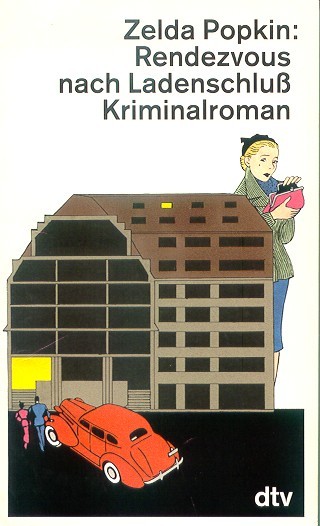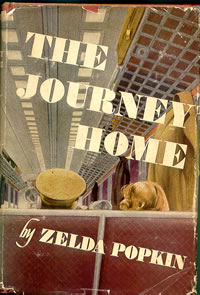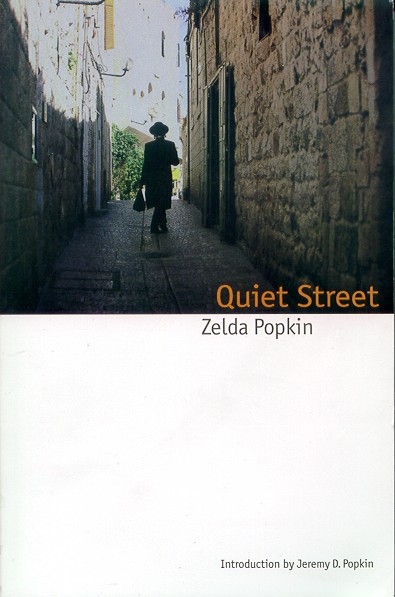Zelda Popkin (1898-1983), my grandmother, was a novelist whose most successful book, The Journey Home, sold nearly a million copies—enough to make any academic like myself envious. Her books, which include a series of mystery novels starring an independent-minded woman detective, one of the earliest American novels to focus on the Holocaust, and the first novel in English about the Israeli struggle for independence and survival in 1948, provide interesting insights into how American women and American Jews faced the great issues of the mid-twentieth century. In 2023, I published Zelda Popkin: The Life and Times of an American Jewish Woman Writer (Rowman and Littlefield), a biography of my grandmother that is also a story of the issues that confronted American Jews and American women of her generation.
Zelda Popkin archives update:
In August 2007, the Popkin family donated a collection of Zelda Popkin's personal letters to her son and daughter-in-law (Richard H. and Juliet Popkin) to the Howard Gottlieb Archival Research Center at Boston University, which also houses Zelda Popkin's literary papers. This series of around 300 letters spans the years from 1943 to 1983 and thus covers most of Zelda Popkin's literary career.
Zelda Popkin’s books:
Popkin published six detective novels from 1938 to 1944. The first five formed a series with a woman detective, Mary Carner, as their protagonist. While Mary Carner was not the first woman detective to feature in such a series, she was quite liberated for her day: she frequently solved her cases while her husband stayed at home to babysit the couple's daughter. The paperback versions of Popkin's detective novels appeared in Dell Books' popular 'map-back' series, with lurid front covers and back covers offering maps of the key locations in the stories.
The Mary Carner detective novels (mysteries featuring Mary Carner, set in the eastern United States)
 |
Death Wears a White Gardenia (Lippincott, 1938; Dell pb, 1938); German translation (Rendezvous nach Ladenschluss, dtv) 1992 |
|
Murder in the Mist (Lippincott, 1940; Dell pb, 1940); German translation (Die Tote Nebenan, dtv); French translation (Meurtre dans la brume, Metailie) 1994 |
|
 |
Dead Man’s Gift (Lippincott, 1941; Dell pb, 1941, 1947); German translation (Ein teuflisches Testament, dtv) 1995; French translation (Le cadeau du mort, Metailie) 1999 |
|
No Crime for a Lady (Lippincott, 1942; Dell pb 1942, 1945); German translation (Die Dame mordet nicht, dtv) 1996 |
|
|
Time Off for Murder (Lippincott, 1943; Dell pb); German translation (Karrierefrauen leben schneller, dtv); French translation (Conges pour meurtre, Metailie) |
Mystery novel not featuring Mary Carner:
- So Much Blood (Lippincott, 1944); German translation (So viel Blut, dtv) 1996
- All six of these detective novels appeared in German translation in the 1990s, and three were translated into French during the same period.
Novels, 1945-1951
 |
The Journey Home (Lippincott, 1945; Dell pb 1945): the story of the encounter between a soldier returning from overseas and a young career woman, set against the dramatic background of a violent train wreck (based on Popkin’s personal experience as a survivor of the highly publicized wreck of the Congresssional Limited in 1943). The Journey Home sold nearly a million copies; letters to Popkin show that it was well received by soldiers who had served in World War II. The book received the honor of a negative review by the young and then largely unknown Saul Bellow in one of the early issues of Commentary magazine. |
|
Small Victory (Lippincott, 1947): based on Popkin’s observations in the post-World War II displaced persons’ camps, which she visited on behalf of the American Red Cross in the winter of 1945-46. The principal characters are American gentiles, but this was one of the earliest American novels in which Jewish survivors of the Holocaust played significant roles. |
|
|
Walk Through the Valley (Lippincott, 1949): the story of a woman who has to recover her independence and make a new life for herself after the sudden death of her husband. This novel strongly reflects Popkin’s personal experience after the death of her husband, Louis Popkin, in 1943. |
|
 |
Quiet Street (Lippincott, 1951; Bison Books pb, 2002): Popkin visited the newly established Jewish state of Israel in the fall of 1948, just after the declaration of independence. This novel was the first American work of fiction devoted to the subject. It is of particular interest because the story is largely told through women characters. |
Autobiography
- Open Every Door (E. P. Dutton, 1956): Originally conceived as a biography of Popkin’s husband Louis, with whom she had run one of the first professional public-relations firms in New York from the 1920s to the early 1940s, this book developed instead into the author’s autobiography, recounting her childhood in small towns in New Jersey and eastern Pennsylvania and her subsequent career. The major source for Popkin’s life.
Novels, 1968-1975
|
Herman Had Two Daughters (Lippincott, 1968; Dell pb 1970): Popkin reworked the story of her early life into this novel about a Jewish family in small-town America in the first half of the twentieth century. This book was her first major commercial success since The Journey Home and enabled her to enjoy a renewed career until old age and illness stopped her from writing. |
|
A Death of Innocence (Lippincott, 1971): the story of a middle-class mother confronting a child who has become involved in a serious crime. A Death of Innocence was made into a television movie in the early 1970s and was translated into Spanish (Inocencia violada, 1972). |
|
Dear Once (Lippincott, 1975; New American Library pb, 1975): based in part on family stories and Popkin’s experiences living in New York and Montreal. |
Sources and Bibliography
- Zelda Popkin’s literary papers are housed in the Howard Gottlieb Archival Research Center department of the Mugar Library, Boston University, as part of the Contemporary American Authors collection. The fourteen cartons of documents include the typed manuscripts of Popkin’s novels, background materials she gathered in preparing her books, correspondence with her editors, with other authors and with personal friends, letters from readers, press clippings (primarily reviews of her books), royalty statements, and some materials concerning her trip to Europe in 1945-6 and her public-relations activities in the 1950s. There are scattered letters from a number of people with whom Popkin came in contact, including Eleanor Roosevelt, the sportscaster Red Barber, and other American Jewish woman authors such as Marie Syrkin and Ruth Gruber. The Special Collections department has a summary inventory of the collection, which is primarily organized into files dealing with each individual book. In August 2007, the Popkin family donated copies of letters from Zelda Popkin to her son and daughter-in-law (Richard H. and Juliet Popkin) from the years 1943 to 1983.
- Members of the Popkin family have some of Popkin’s personal correspondence, primarily letters written to Zelda Popkin by other members of the family. These include perhaps 500 letters and postcards from Popkin’s father, Harry Feinberg, spanning the years 1938-1959, and approximately 100 letters from Palestine/Israel written by her sister Helen Rossi Koussewitsky, who lived in Jerusalem from 1936 onward and wrote extensively for the Palestine Post (later Jerusalem Post).
- Biographical information provided by Zelda Popkin herself can be found in her autobiography, Open Every Door (E. P. Dutton, 1956), and her entry in Contemporary Authors, first revision, vs. 25-8 (1977).
- Scholarship on Zelda Popkin’s novels includes Kathleen Gregory Klein, The Woman Detective: Gender and Genre (University of Illinois Press, 1988), pp. 143-6 (on the Mary Carner detective novels and their place in the development of mystery literature), Jeremy D. Popkin, "A Forgotten Forerunner: Zelda Popkin’s Novels of the Holocaust and the 1948 War," in Shofar v. 20 (fall 2001), pp. 37-60, Ellen Serlen Uffen, Strands of the Cable: The Place of the Past in Jewish American Women’s Writing (Peter Lang, 1994), pp. 95-109 (on Popkin’s novel of American Jewish family life, Herman Had Two Daughters), and Mary Jean DeMarr, "The Mysteries of Zelda Popkin," _Clues: A Journal of Detection_ 3 (1982), 1-8.
- Zelda Popkin published over 100 magazine and newspaper articles between 1917 and 1969. Here is a bibliography of those I have located: Last updated: 7 March 2023
- By Zelda Feinberg:
“Hope Springs Eternal—Seeing ‘Papa’ Joffre.” Wilkes-Barre Times Leader, 12 May 1917.
“Home Comforts for the Soldiers,” American Hebrew, v. 104, 8 Nov. 1918, 15-6.
“The East Side Emerges,” American Hebrew v. 104, 15 Nov. 1918, 27.
“An Oasis in the East Side,” American Hebrew v. 104, 15 Nov. 1918, 41-2.
“Jewish Women with the A.E.F.,” American Hebrew v. 104, 11 April 1919, 524, 544, 597.
By Zelda Popkin:
“The Council’s Work on Blackwell’s Island,” Womankind, 16 Apr. 1920, 5.
“Women to ‘Sell’ Philanthropy.” American Hebrew, v. 107, 10 Sept. 1920, 440.
“A new adventurer in the promised land,” (review of Yezierska, Hungry Hearts) American Hebrew v. 108, 3 Dec. 1920, 112-3.
“Spotting ‘Star Dust’” (review of Fanny Hurst) American Hebrew, v. 108, 29 Apr. 1921, 712.
“Rachel as Viewed by a Writer of Her Day.” American Jewish World (Minneapolis), 8 July 1921.
“Jewish Dolly Madisons,” American Hebrew, v. 109, 30 Sept. 1921, 488, 514-5.
“Who’s Who in the Short Story—1921,” American Hebrew, v. 110, 86, 126.
“Romain Rolland and the Jews” American Hebrew , v. 110, 7 Apr. 1922, 542.
“All Dressed Up—No Place to Go: Jews of the Bronx Charged with Lack of Community Spirit in Failing to Provide Adequate Facilites for Training of their Boys and Girls.” Jewish Tribune, 7 Apr. 1922, 2, 10.
“Mother Love in Mean Streets”, American Hebrew, v. 110, 5 May 1922, 700.
“A Jewish Palette: Theresa Bernstein Wins Laurels as Painter,” American Hebrew v. 111, 16 June 1922, 133, 135.
“The Changeable Petticoat,” American Hebrew v. 111, 14 July 1922, 221, 224, 228.
“That’s A Strike.” Nation, v. 115, 23 Aug. 1922, 185-6.
“Do It Before You Are Forty!” American Hebrew, 17 Nov. 1922, 7, 14.
“A Barn for School.” Survey, v. 49, Nov. 15, 1922, 253-255.
“Curb Lizards,” American Hebrew, v. 112, 24 Nov. 1922, 30, 32, 33, 34.
“Rachel Felix, The Daughter of a Jewish Peddler Who Became One of the World’s Great Tragediennes,” Jewish Tribune, 3 Aug. 1923, 11.
“National Jewish Hospital for Consumptives,” American Israelite, 22 Aug. 1923, 1.
Review of Lummox, by Fannie [sic] Hurst, American Hebrew v. 113, 2 Nov. 1923, 672-3.
“An Experiment in Education,” American Hebrew, v. 113, 28 Dec. 1923.
“New York State Sisterhoods Outside of the Metropolis,” American Hebrew v. 114, Jan. 1924, 236, 246.
“’The Jew and Civilization’: A Review of Ada Sterling’s Remarkable Book Just From The Press,” American Israelite, 24 Feb. 1924, 1.
Review of My Musical Life, by Walter Damrosch, American Hebrew v. 114, 29 Feb. 1924, 473.
“What Shall We Do with Babies? An Interview with Mrs. Stephen S. Wise,” Jewish Tribune, 14 March 1924, 58.
Review of Theodore Dreiser, The Color of a Great City, American Hebrew, v. 114, 18 Apr. 1924, 724.
Review of Zona Gale, Birth, American Hebrew v. 115, 6 June 1924, 144.
Zelda Popkin, “’Rabbit’,” Jewish Tribune, 26 Sept. 1924, 24, 32.
“The Caravan of Hope in Europe: A Regenerated People Sing Praises of Providence and O.R.T.” American Israelite, 4 Dec. 1924, 1.
“From Broadway to Broadway: Gustav Blum, Who Began as the Hamlet of the Eureka Dramatic Society,” Jewish Tribune, 5 Dec. 1924, 44.
“The Foothills of Ararat: The Story of a Very Sick Little Boy Who Lived in the Dream of a New Zion,” Jewish Tribune, 3 Apr. 1925, 34, 36.
“Woman Artist Adds to Laurels,” Jewish Tribune, 22 May 1925, 26.
“The Paradox of John Singer Sargent,” American Hebrew, v. 117, 26 June 1925, 229.
Review of Luigi Pirandello, Three Plays, and Ferencz Molnar, The Swan, American Hebrew v. 117, 3 July 1925, 281.
Review of Beatrice Kean Seymour, Unveiled, American Hebrew, v. 117, 31 July 1925, 363.
Review of William Henry Warner, Sacrilegious Hands, American Hebrew, v. 117, 14 Aug. 1925, 425.
“Gloucester Hangs Art on Its Trees” NY Times Magazine, 6 Sept. 1925, 17, 21.
“Nearly Seventy Thousand Volumes in College Library” American Israelite, 22 Oct. 1925.
“A Storehouse of Historic Treasures. The Hebrew Union College Library Has One of the World’s Riches Collections of Judaica” Jewish Tribune, 23 Oct. 1925, 4.
“Mistress and Maid in Autumn Line-Up,” Daily News (Los Angeles), 8 Nov. 1925, 11.
Review of The Happy Failure, by Solita Solano, American Hebrew, v. 118, 4 Dec. 1925, 167.
Review of Maximilian Harden, I Meet My Contemporaries, American Hebrew, v. 118, 16 Apr. 1926.
“East Side Night Life,” New Yorker, 5 June 1926, 68-9.
“Jewish Daughters of the Revolution,”Jewish Tribune, 2 July 1926, 3, 17.
“The Hebrew Union College Library is Leader of Jewish Learning,” American Israelite, 19 Aug. 1926, 1, 5.
“The Synagogue in the Wilderness: First Place of Worship in Pennsylvania Founded by Early Colony Near Lancaster,” American Hebrew, v. 119, 10 Sept. 1926, 522, 577.
“Reflections of Silent New Yorkers,” New Yorker, 30 Oct. 1926, 38-9.
“Reflections of More-or-Less Silent Citizens,” New Yorker, 11 Dec. 1926, 103-4.
“Reflections of Silent Citizens,” New Yorker, 12 Feb. 1927, 82.
“Changing East Side”. American Mercury, v. 10 (Feb. 1927), 168-175.
“Reflections of Silent Citizens: The Bus Conductor,” New Yorker, 26 Feb. 1927, 69.
“The Jew and Aviation,” B’nai Brith Magazine XLI, no. 10 (July 1927), 417-8.
“The Jewish Covered Wagon,” B’nai Brith Magazine XLI, no. 11 (Aug. 1927), 453-4, 476.
“A Good School for the Children,” New Yorker, 10 Sept. 1927, 55.
“The Jew on Stage and Screen,” B’nai Brith Magazine XLII, no. 1 (Oct. 1927), 548-9.
“The Rivals of Bridge that Come and Go,” New York Times, 30 Oct. 1927.
“The Jew on Stage and Screen,” B’Nai Brith Magazine XLII, no. 2 (Nov. 1927) 18-19.
“Abdication of King Coal,” Nation, v. 126 (4 Jan. 1928), 11-12.
“Class of ’28 Gets Down to Business,” New Yorker, 19 Oct. 1928, 92-4.
“A South African Writes About the Jews,” B’Nai Brith Magazine v. 43 (Nov. 1928), 66-7.
“Gloucester Honors its Sailors,” Nation, v. 128 (17 Apr. 1929), 448-9.
“The Jewish Woman’s Golden Age,” American Hebrew, 22 Nov. 1929, 56, 90, 94, 102-103, 111-2.
“Russia Goes to the Movies,” Outlook and Independent, v. 155 (28 May 1930), 129-31, 154-55.
“Tent Show Turns to Sex,” Outlook and Independent, v. 156 (24 Sept. 1930), 128-130, 157.
“Art: Three Aisles Over,” Outlook and Independent, v. 156 (26 Nov. 1930), 502-3, 515-6.
“Panic of the Parents,” Outlook and Independent, v. 158 (1 July 1931), 267-9, 286.
“Heaven Bound: Authentic Negro Folk Drama Out of Old Savannah,” Theatre Guild, v. 11, 6 Aug. 1931, 14-17.
“Wonderful Institution, Our Schools,” New Yorker, 14 Nov. 1931, 82-6.
“Camera Explorers of the New Russia,” Travel, v. 58 (Dec. 1931), 37-40, 52-4.
“Saturday Morning at Carnegie,” New Yorker, 6 Feb. 1932.
“Finer Things of Life,” Harper’s Magazine, v. 164 (Apr. 1932), 602-611.
“Conciliation Court,” New Yorker, 10 Sept. 1932, 40-7.
[Anonymous] “The American Jewish Tragedy,” The Jewish Criterion (Pittsburgh) 30 Sept. 1932.
“Children of the Racketeer Age,” Harper’s Magazine, v. 166 (Feb. 1933), 364-75.
“Boy Wonder,” New Yorker, 4 Aug. 1933, 40-2.
“Sociological Court is Urged for Women,” New York Times, 25 Nov. 1934.
“Folk Festivals Lure: Annual Trips Begin in May to Centers of Primitive American Arts and Music,” New York Times, 21 Apr. 1935, p. X13.
“Vignettes from a Women’s Court,”, Independent Woman, v. 14 (Dec. 1935), 398-400, 414-6.
“Magistrates’ Courts Bureau is Designed to Deal With Problems Presented by Arraigned Persons,” New York Times, 5 Jan. 1936, 166.
“Gone With the Flood,” New Yorker, 24 Oct. 1936, 32, 34, 36-9.
“Not to Reason Why,” New Yorker, 6 March 1937, 23-4.
“Annals of Crime: Sing a Song of Homicide,” New Yorker, 30 Oct. 1937, 46-56.
“The Trousseau,” New York Daily News, 23 Sept. 1938.
“Madame Jumel: Vice-Queen” American Mercury v. 48 (Nov. 1939), 327-333.
“Highest Standard of Living on Earth,” Independent Woman, v. 19 (Apr. 1940), 101.
“A Corpse Can’t Leer,” Writer v. 55 (Oct. 1942), 291-94.
“A Widow’s Way,” McCalls, Oct. 1945, 59-60, 66, 68.
“Shoes for the Children of Drancy,” Reader’s Digest, v. 48 (Mar. 1946), 36-8.
“Europe’s Children.” Lady’s Home Journal, v. 63 (Aug. 1946), 168, 170-1.
“Glory at Twilight,” American Magazine, v. 144 (Oct. 1947), 48-9.
“New Youth for a New Land,” Parents Magazine, v. 24, (1949) 36-7, 84.
“Widows and the Perilous Years,” Harper’s Magazine, v. 199 (Sept. 1949), 69-75.
“Bitter Bondage,” American Magazine, v. 149 (May 1950), 52-58.
“Tolerance: For Snobs Only,” Negro Digest 10 (Nov. 1951), 38-9. (Originally in Compact magazine, Sept. 1951.)
“Anyone can be brave!” Coronet, v. 33 (Nov. 1952), 100-3.
“What Are We Afraid Of?” Coronet, v. 33 (Feb. 1953), 36-38.
“If Tragedy Comes,” Coronet, v. 33 (Mar. 1953), 61-4.
“What Do You Know About Love?” Coronet v. 33 (Apr. 1953), 138-40.
“Some New Ways of Making Friends”. Coronet, v. 34 (Aug. 1953), 98-100.
“What’s Right with Our Schools,” Coronet, v. 34 (Oct. 1953), 23-28.
“Middle Age: The Time to Live,” Coronet, Dec. 1953, v. 35, 162-5.
“Something for Nothing,” Coronet, v. 35 (Jan. 1954), 124-126.
“Budget Your Emotions,” Coronet v. 35 (Feb. 1954), 154-6.
“Technical Charge of Homicide,” New Yorker, v. 30 (13 Mar. 1954), 100, 102-10.
“Plot Isn’t a Dirty Word,” Writer, v. 82 (July 1969), 11-2.
